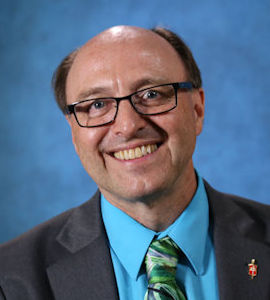In this month’s blog, The Joyful Journey, Bishop David A. Bard remembers a Grammy-winning song and views the 2019 General Conference as a tapestry rich in the love of God.
BISHOP DAVID BARD
Michigan Area United Methodist Church
 One of the pleasures Julie and I discovered when we moved to Michigan and the Lansing area were the Broadway productions at the Wharton Theater. While we have not been frequent attendees, we have had the pleasure of watching a few shows. One we enjoyed a lot was “Beautiful: The Carole King Musical.” Carole King and her first husband, Gerry Goffin, wrote many charted hits together, music performed and recorded by other musicians, songs such as “Up On the Roof” for the Drifters or “You Make Me Feel (Like a Natural Woman)” for Aretha Franklin. The musical focuses on the story of Carole King’s musical development and her relationship with Goffin, a relationship that ended in divorce. The show ends as Carole King begins a solo career, which quickly takes off with her 1971 album, Tapestry.
One of the pleasures Julie and I discovered when we moved to Michigan and the Lansing area were the Broadway productions at the Wharton Theater. While we have not been frequent attendees, we have had the pleasure of watching a few shows. One we enjoyed a lot was “Beautiful: The Carole King Musical.” Carole King and her first husband, Gerry Goffin, wrote many charted hits together, music performed and recorded by other musicians, songs such as “Up On the Roof” for the Drifters or “You Make Me Feel (Like a Natural Woman)” for Aretha Franklin. The musical focuses on the story of Carole King’s musical development and her relationship with Goffin, a relationship that ended in divorce. The show ends as Carole King begins a solo career, which quickly takes off with her 1971 album, Tapestry.
If you were a teenager or young adult in the 1970s, you know this album. It included songs such as “So Far Away,” “It’s Too Late,” “You’ve Got a Friend,” her own version of “You Make Me Feel (Like a Natural Woman),” and the song the musical is named after, “Beautiful.” “Beautiful” offered these of advice: “You’ve got to get up every morning, with a smile on your face, and show the world all the love in your heart.” The music remains familiar to many because this album was awarded the 1972 Grammy for album of the year, and stayed on the charts for six years. For me, that means it came out when I was 12 and was still selling strong when I was 18. Right now, if you feel like it, you have my permission to stop reading, find your old vinyl copy of Tapestry, or your newer CD, or find it on your favorite streaming music source, and just listen for a while. This essay will still be waiting for you when you get back.
The title song of the album uses the image of a tapestry in framing a life. “My life has been a tapestry of rich and royal hue; an everlasting vision of the ever-changing view; a wondrous woven magic in bits of blue and gold; a tapestry to feel and see, impossible to hold.”
I do not knit or crochet or weave, but images of weaving and of tapestries have become important to me in my life and faith. Listen to some familiar words from the apostle Paul. For though I am free with respect to all, I have made myself a slave to all, so that I might win more of them. To the Jews, I became as a Jew, to win Jews. To those under the law, I became as one under the law (though I myself am not under the law) so that I might win those under the law. To those outside the law, I became as one outside the law (though I am not free from God’s law but am under Christ’s law) so that I might win those outside the law. To the weak, I became weak, so that I might win the weak. I have become all things to all people, that I might, by all means, save some. I do it all for the sake of the gospel, so that I may share in its blessings. (I Corinthians 9:19-23)
One could take Paul’s words, “I have become all things to all people,” as evidence of spineless leadership, as exponential people-pleasing. I hear instead someone weaving different important values together in different ways as the occasion requires. Paul is not without values, he has multiple values and understands the need to weave those together in different ways at different times in service of a core value of bringing people into the orbit of God’s love in Jesus Christ.
Our lives and our life in faith asks of us, I think, this kind of weaving and re-weaving. We are all, in part, products of our past experiences. Some of those experiences may have been deeply painful and wounding. Part of our task as followers of Jesus, and by the power of God’s grace, is to weave and re-weave those past experiences into our present lives in different ways over time, in ways that are more and more life-enhancing. We all know people who seem captive to their past experiences, never able to weave a new tapestry. We cannot change the past, but we can find ways to weave it differently into our present so as not to be held captive by it. Sometimes that work is difficult, for to weave a new tapestry we may need to make some deep cuts into the current pattern. What holds true for us individually also holds true for our churches. Change can be difficult.
As the appointive cabinet and I work on pastoral appointments, we work prayerfully to be artistic weavers in service of the ministry of Jesus Christ. We ask churches and charges to think about their ministry priorities at this time in their life. At different stages in the life of a church, different values are important. We ask pastors about their gifts and how they would like us to think about their appointment in light of those gifts and the kind of family considerations that also matter to their effectiveness. We seek the guidance of the Spirit as we attempt to weave all these together. Sometimes the weave does not work as we had hoped, and a new weave, a new tapestry needs to be created.
We are approaching the special called session of the General Conference of The United Methodist Church later this month. As I have tried to describe the three major plans coming to the General Conference from the Commission on a Way Forward, images of weaving have been helpful. All three plans can be considered a response to the question about how adequate our current tapestry is as a church in relationship to LGBT persons and their families. Our current denominational weave says that all persons, including LGBT persons, are of sacred worth and in need of the ministry of the church. It also says that LGBT persons can only be woven into the fabric of the church in certain ways, excluding marriage and ordination.
Each plan presents a different tapestry, some with a tighter weave that asks some to begin another tapestry, some with a looser weave that provides needed space for and between people at this time in the history of our church. Each plan also weaves together important Wesleyan values differently. It remains crucial to see each plan as rooted in important Wesleyan values – values such as the centrality of Scripture, accountability, the wideness, and pervasiveness of God’s grace, reading our Scripture in light of breadth of reading (Wesley read widely). Each plan weaves those values together differently and the elected delegates will decide how we want to weave Wesleyan values together moving into the future. Continue to pray for this General Conference, knowing that whatever the vote, people will experience the pain that accompanies a kind of tearing of a tapestry.
In thinking about the role of bishops at this upcoming General Conference, I have also been thinking about tapestries. In traveling throughout the conference these past few months, one critically important value I held was presenting as much good and accurate information in as straightforward a way as possible. I hope that was evident in my listening sessions this fall and winter. When asked, and in some other forums, I have also been open in saying that I supported the majority position of the Council of Bishops which was to forward all three Commission on a Way Forward plans to the General Conference. I believe the adoption of the One Church Plan as the best way into the future given where we are right now in our history. I know that this has been to the delight of some, the dismay of some, and the disdain of some. There are those who ask how any bishop who has expressed a preference for a plan might preside at General Conference, which is our key role at this gathering.
My response is weaving. The presiding role means that the values of fairness, procedural competence and graciousness become the brightest colors in our tapestries.
Before I write my next blog, this General Conference will be in the past. I know there will be feelings of tapestries rent apart. There may be those who find what is woven together at General Conference to be so lacking in beauty that they simply want to begin with new fabric. There will be unknit corners and frayed edges in the tapestry of our denomination. Leading after General Conference will require that we, with our keenest thinking and our most capacious hearts, seek to weave a new future so that the ministry of Jesus Christ might continue and thrive. At different times, we will need to weave a variety of values together in different ways, now highlighting this value, now that value.
At the heart of all our weaving, though, the thread that holds all our tapestries together is the love of God in Jesus Christ. In God’s love, we are reminded that our lives are tapestries of rich and royal hue, all of our lives. In God’s love we are, all of us, wondrous woven magic in bits of blue and gold. Knowing this, and reminding each other of this, may help us find, yes indeed, that we are beautiful. I remain committed to a church that helps people know God’s love and feel their beauty, that helps people grow in God’s love — weaving that love ever more deeply into their lives — and that helps people show God’s love by working together in the power of the Spirit to weave a more beautiful world.
I look forward to continued working with you to weave such a church.
Last Updated on September 20, 2022

